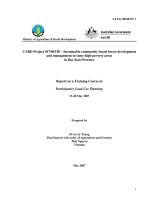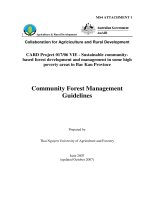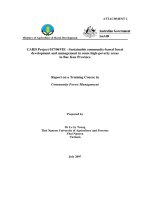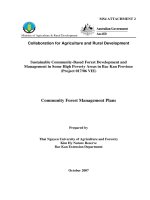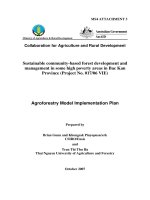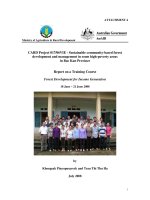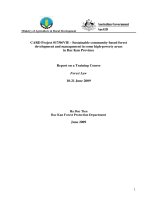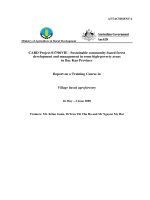Assessing livelihood capitals and outcomes for forest dependence households in van hoc commune, na ri district, bac kan province
Bạn đang xem bản rút gọn của tài liệu. Xem và tải ngay bản đầy đủ của tài liệu tại đây (535.56 KB, 94 trang )
1
ACKNOWLEDGEMENT
Similar to a thousand of senior student in Vietnam National
University of Agriculture, I carried out to implement the Undergraduate Thesis
about: "Assessing livelihood capitals and outcomes for forest dependence
households in Van Hoc commune, Na Ri district, Bac Kan province.
” During the thesis work, I have faced many difficulties and make
mistakes but I also have received help from my supervisor, friends and family.
So I could finish my thesis and had useful experiences in the real life to support
my future career.
Therefore, it is my privilege to express the feelings of my gratitude to all
those who helped me directly or indirectly to complete this thesis. I also would
like to thank the Viet Nam National University of Agriculture and Accounting &
Business Management Faculty for allowing me to initiate this thesis, to do
necessary tasks and to use the department materials.
Furthermore, I would like to express my gratefulness to my advisor
Nguyen Hai Nui for the continuous support of my study and research, for his
patience, motivation, enthusiasm, and immense knowledge. His guidance helped
me in all the time of research and writing of this thesis.
I am also extremely grateful to all of people lived in Van Hoc commune
who enthusiastically helped and gave me convenient conditions during
conducting my survey at this place.
Last but not least, I would like to sincerely thank my family, friends for
supporting and encouraging me to complete my thesis comprehensively.
Sincerely,
Ha Noi, 15th August 2016
Student
NGO THI HUONGNgo Thi Huong
2
TABLE OF CONTENTS
ACKNOWLEDGEMENT............................................................................................................................................1
……................................................................................................................................................................................79
APPENDIX...................................................................................................................................................................80
ACKNOWLEDGEMENT............................................................................................................................................1
……................................................................................................................................................................................79
APPENDIX...................................................................................................................................................................80
3
LIST OF TABLES
Table 3.1.
The forest dependence scale...Error: Reference source not found
Table 3.2:
Livelihood platform variables.Error: Reference source not found
Table 4.1.
General information of surveyed households.....Error:
Reference
source not found
Table 4.2.
General information of surveyed household headError: Reference
source not found
Table 4.3:
The vulnerability context of households in Van Hoc in 2015Error:
Reference source not found
Table 4.4.
Human capital of households in Van Hoc commune...........Error:
Reference source not found
Table 4.5:
Education background of house hold headError: Reference source
not found
Table 4.6:
Social capital of households. . .Error: Reference source not found
Table 4.7:
Detail of social capital............Error: Reference source not found
Table 4.8.
Financial capital of households in Van Hoc commune.......Error:
Reference source not found
Table 4.9:
Financial statistics of household's incomeError: Reference source
not found
Table 4.10: Details of the financial capital of householdsError: Reference source
not found
Table 4.11: Physical capital of household....Error: Reference source not found
Table 4.12: Housing situation and housing quantity of household...........Error:
Reference source not found
Table 4.13: Natural capital of household......Error: Reference source not found
Table 3.14: Summary statistics for income by Forest dependence levels. Error:
Reference source not found
4
Table 4:15: Some indicators to assess the results of livelihoodError:
Reference
source not found
Table 4:16: The level of indicators evaluating the results of livelihood. . .Error:
Reference source not found
Table 4:17: Review human resources and propose solutions...Error:
Reference
source not found
Table 4:18: Assessment of social resources and propose solutions..........Error:
Reference source not found
Table 4:19: Review financial resources and propose solutionsError:
Reference
source not found
Table 4:20: Assessment of natural resources and propose solutions.........Error:
Reference source not found
Table 1: Livelihood platform variables
Table 3.1: . The forest dependence scale
Table 3.2: . Housing situation variables
Table 4.1: . General information of surveyed households
Table 4.2: . General information of surveyed household head
Table 4.3: The vulnerability context of households in Van Hoc in 2015
Table 4.4: . Human capital of households in Van Hoc commune
Table 4.5: Education background of household head
Table 4.6: Social capital of households
Table 4.7: Detail of social capital
Table 4.8: . Financial capital of households in Van Hoc commune
Table 4.9: Financial statistics of household's income
Table 4.10: Details of the financial resources of households
Table 4.11: Physical capital of household
5
Table 4.12: Housing situation and housing quantity of household
Table 4.13: Natural capital of household
Table 2.14: Summary statistics for income by Forest dependence levels
Table 4:154: Some indicators to assess the livelihood outcomes
Table 4:165: The level of indicators evaluating the livelihood outcomes
Table 4:176: Review human resources and propose solutions
Table 4:187: Assessment of social resources and propose solutions
Table 4:198: Review financial resources and propose solutions
Table 4:2019: Assessment of natural resources and propose solutions
6
LIST OF FIGURES
Figure 2.1. Livelihood assets pentagon.......Error: Reference source not found
Figure 2.2. Sustainable livelihood frameworkError: Reference source not found
Figure 3.1. Conceptual framework..............Error: Reference source not found
Figure 2.1. Livelihood assets pentagon
Figure 2.2. Sustainable livelihood framework
Figure 3.1. Conceptual framework
7
LIST OF ABBREVIATIONS
CEMA
DFID
HH
LS
LS1
LS2
LS3
NGOs
PRA
Committee for Ethnic Minority and Mountainous Area Affairs
Department for International Development
Household
Livelihood Strategy
Less Dependent on Forest Livelihood Strategy
Moderately Dependent on Forest Livelihood Strategy
High Dependent on Forest Livelihood Strategy
Non-Governmental Organizations
Participatory Rural Appraisal
8
9
CHAPTER 1. INTRODUCTION
1.1. Rationale of the Study
A livelihood is defined as comprising ‘‘the capabilities, assets
(including both material and social resources) and activities required for a means
of living. A livelihood is considered to be sustainable when it can cope with and
recover from stress and shocks and maintain or enhance its capabilities and
assets both now and in the future, while not undermining the natural resource
base". Each household has a different policy in line with the natural, the
financial, social and available human conditions to maintain livelihood.
However, today, securing the livelihoods of people still also meet many
difficulties due to many different reasons such as customs are still backward, the
use of resources is not the right purpose and the resources are not exploited
effectively, ...
With the goal of poverty reduction, sustainable development, the
protection and development of sustainable livelihoods for households is an
important activity in rural development. Ensuring the household livelihood is to
help people cope and recover from shocks and heavy stresses. This will maintain
and even enhanced the capabilities and assets both in the present and future
without photo based affect natural resources.
Forests play a crucial role to the livelihood of communities in
developing countries. While not only contributing to the green economy by
creating a safer, healthier living environment. It also provide a great deal
services for human and production development alike. Shelter, food, gas
emissions, and a source of spiritual and cultural life of the communities living
by forests.
Van Hoc is a commune in Na Ri district, BacKan province, Vietnam. It is
located bordering communes with localities as follows: In the North it borders
10
on Vu Loan commune and Luong Ha commune; on Luong Ha commune and
Lang San commune to the East ; on Lang San to the West.
To ensure the livelihood resources for forest-dependent households in
Van Hoc commune, local authorities is advised to guide the people to effectively
exploit the use of available resources. To educate and to raise awareness to the
cause of poverty will help reduce investment mistakes and increase capital
preservation Monitoring and evaluating the effectiveness of the livelihood of the
people is also an important issue in the process of helping people to develop
sustainable livelihoods.
In recent years, Van Hoc's economy has developed quite strongly. Local
investment focused on transportation infrastructure; improve the means of
production, applied science and technology, which contribute to improving
productivity, labor efficiency. However, rapidly growing population is placing a
request for the allocation of the use of resources to meet the needs of future
development.
Stemming from the fact that we choose to study the topic: "Assessing
livelihood capitals and outcomes for forest dependence households in Van Hoc
commune, Na Ri district, Bac Kan province.”
1.2. Objectives of the Study
1.2.1. General Objectives
Analyzing current situation of livelihood capitals and outcomes, for
forest dependence households. From which, proposing some orientations and
measures to improve livelihood capitals and outcomes for forest dependence
households in Van Hoc commune, Na Ri district, Bac Kan province.
1.2.2. Specific Objectives
•Contributing systematize theoretical basis and practical livelihood,
resources and the livelihoods of forest dependence households.
11
•Assessing of the status of the livelihood capitals and outcomes for forest
dependence households in Van Hoc commune, Na Ri district, Bac Kan province.
•Recommending some orientations and measures to improve the
livelihood outcomes in Van Hoc commune, Na Ri district, Bac Kan province.
1.3. Research Questions
•What are the elements affecting livelihood outcomes, livelihood capitals,
on forest dependence households?
•What are the different situations among three groups: less dependent,
moderately dependent and highly dependent on forest?
•How did the elements affect livelihood capital selection?
how the
livelihood capital affect livelihood outcomes?
•Does household has less livelihood assets will depends on forest more?
•What are the solutions to promote the effectiveness of livelihood
activities and improve the living quality in Van Hoc commune, Na Ri district,
BacKan province?
1.4. Scope of the study
1.4.1. Research Object
Research on livelihood resources, forest dependence, and other
related factors in Van Hoc commune, Na Ri district, Bac Kan province.
1.4.2. Research Scope
• Scope of content: Assessing livelihood capitals and outcomes for forest
dependence households in Van Hoc commune, Na Ri district, Bac Kan province
• Scope of space: Van Hoc commune, Na Ri district, Bac Kan province.
• Scope of time: From Jan 14, 2016 to Aug 10, 2016.
12
CHAPTER 2. LITERAUTURE REVIEW
2.1. Basic definitions and concepts
a) Livelihood
A livelihood is defined as comprising ‘‘the capabilities, assets (including
both material and social resources) and activities required for a means of living.
A livelihood is considered to be sustainable when it can cope with and recover
from stress and shocks and maintain or enhance its capabilities and assets both
now and in the future, while not undermining the natural resource base”
(Carney, 1998, 2002; DFID, 1999).
b) Livelihood assets
Livelihood assets refer to human and non-human resources (natural,
physical, human, social and financial) upon which livelihoods are built and to
which people need access. The assets constitute a stock of capital that can be
stored, accumulated, exchanged or allocated to activities to generate a flow of
income or means of livelihoods or other benefits (Rakodi, 1999).
c) Livelihood strategy
This denotes the range and combination of activities and choices
that people make and undertake ways of combining and using assets in order to
achieve their livelihood goals (DFID, 1999).
d) Sustainable livelihood
A livelihood is sustainable when it can cope with and recover from
stresses and shocks and maintain or enhance its capabilities and assets both now
and in the future, while not undermining the natural resource base (Carney, 1998).
Livelihoods are sustainable when they: (i) are resilient in the face of
external shocks and stresses; (ii) are not dependence upon external support (or if
they are, this support itself should be economically and institutionally
sustainable); (iii) maintain the long-term productivity of natural resources and;
13
(iv) do not undermine the livelihoods of, or compromise the livelihood options
open to, others (DFID, 1999).
2.2. Sustainable livelihood framework
The livelihoods framework (Figure 1.1) is a tool to improve our
understanding of livelihoods, particularly the livelihoods of the poor. It was
developed by Department for International Development (DFID) in1999. The
framework does not attempt to provide an exact representation of reality.
However, it endeavors to provide a way of thinking about the livelihoods of
poor people that will stimulate debate and reflection, thereby improving
performance in poverty reduction. In its simplest form, the framework views
people as operating in a context of vulnerability. Within this context, they have
access to certain assets or poverty reducing factors. These gain their meaning
and value through the prevailing social, institutional and organizational
environment. This environment also influences the livelihood strategies ways of
combining and using assets that are open to people in pursuit of beneficial
livelihood outcomes that meet their own livelihood objectives (DFID, 1999).
2.2.1 Vulnerability context
The Vulnerability Context Frames the external environment in
which people exist. People’s livelihoods and the wider availability of assets are
fundamentally affected by critical trend as well as by shocks and seasonality
over which they have limited or no control. For examples:
• Trends: Population trends, resource trends, national/international economic
trends, trends in governance (including politics), technological trends, etc.
• Shocks: Human health shocks, natural shocks, economic shocks,
conflict, crop/livestock health shocks, etc.
• Seasonality: Of prices, of production, of health, of employment
opportunities, etc.
Vulnerability Context is important because they have a direct
14
impact upon people’s asset status and the options that are open to them in
pursuit of beneficial livelihood outcomes. Shocks can destroy assets directly (in
the case of floods, storms, civil conflict, etc.). They can also force people to
abandon their home areas and dispose of assets (such as land) prematurely as
part of coping strategies. Recent events have highlighted the impact that
international economic shocks, including rapid changes in exchange rates and
terms of trade, can have on the very poor. Trends may (or may not) be more
benign, though they are more predictable. They have a particularly important
influence on rates of return (economic or otherwise) to chosen livelihood
strategies. Seasonal shifts in prices, employment opportunities and food
availability are one of the greatest and most enduring sources of hardship for
poor people in developing countries.
2.2.2. Livelihood. Livelihood assets
Human capital: Human capital represents the skills, knowledge, ability
to labor and good health that together enable people to pursue different
livelihood strategies and achieve their livelihood objectives. At a household
level, human capital is a factor of the amount and quality of labor available; this
varies according to household size, skill levels, leadership potential, health
status, etc.
Human capital appears in the generic framework as a livelihood asset,
that is, as a building block or means of achieving livelihood outcomes. Its
accumulation can also be an end in itself. Many people regard ill health or lack
of education as core dimensions of poverty and thus overcoming these
conditions may be one of their primary livelihood objectives. As well as being
of intrinsic value, human capital (knowledge and labor or the ability to
command labor) is required in order to make use of any of the four other types
of assets. It is therefore necessary, though not on its own sufficient, for the
achievement of positive livelihood outcomes.
15
Social capital: There is much debate about what exactly is meant by the
term ‘social capital’. In the context of the sustainable livelihoods framework, it
is taken to mean the social resources upon which people draw in pursuit of their
livelihood objectives. These are developed through: (i) networks and
connectedness, either vertical (patron/client) or horizontal (between individuals
with shared interests) that increase people’s trust and ability to work together and
expand their access to wider institutions, such as political or civic bodies; (ii)
membership of more formalized groups which often entails adherence to mutually
agreed or commonly accepted rules, norms and sanctions; (iii) relationships of
trust, reciprocity and exchanges that facilitate co-operation, reduce transaction costs
and may provide the basis for informal safety nets amongst the poor.
Mutual trust and reciprocity lower the costs of working together.
This means that social capital has a direct impact upon other types of capital: By
improving the efficiency of economic relations, social capital can help increase
people’s income and rates of saving (financial capital). Social capital can help to
reduce the ‘free rider’ problems associated with public goods. This means that it
can be effective in improving the management of common resources (natural
capital) and the maintenance of shared infrastructure (physical capital). Social
networks facilitate innovation, the development of knowledge and sharing of
that knowledge.
There is, therefore, a close relationship between social and human
capital.
Social capital, like other types of capital, can also be valued as a good in
itself. It can make a particularly important contribution to people’s sense of
well-being.
Natural capital: Natural capital is the term used for the natural resource
stocks from which resource flows and services (e.g. nutrient cycling, erosion
protection) useful for livelihoods are derived. There is a wide variation in the
16
resources that make up natural capital, from intangible public goods such as the
atmosphere and biodiversity to divisible assets used directly for production. For
examples of natural capital and services deriving from it: Land, forests,
marine/wild resources, water, air quality, erosion protection, waste assimilation,
storm protection, biodiversity degree and rate of change.
Within the sustainable livelihoods framework, the relationship
between natural capital and the Vulnerability Context particularly close. Many
of the shocks that devastate the livelihoods of the poor are themselves natural
processes that destroy natural capital (e.g. fires that destroy forests, floods and
earthquakes that destroy agricultural land) and seasonality is largely due to
changes in the value or productivity of natural capital over the year.
Natural capital is very important to those who derive all or part of
their livelihoods from resource-based activities (farming, fishing, gathering in
forests, mineral extraction, etc.). However, its importance goes way beyond this.
None of us would survive without the help of key environmental services and
food produced from natural capital. Health (human capital) will tend to suffer in
areas where air quality is poor because of industrial activities or natural disasters
(e.g. forest fires).
Physical Capital: Physical capital comprises the basic infrastructure
and producer goods needed to support livelihoods. Infrastructure consists of
changes to the physical environment that help people to meet their basic needs
and to be more productive. Producer goods are the tools and equipment that
people use to function more productively. The following components of
infrastructure are usually essential for sustainable livelihoods: (i) affordable
transport; (ii) secure shelter and buildings; (iii) adequate water supply and
sanitation; (iv) clean, affordable energy; (v) and access to information
(communications).
Infrastructure is commonly a public good that is used without direct
17
payment. Exceptions include shelter, which is often privately owned, and some
other infrastructure that is accessed for a fee related to usage (e.g. toll roads and
energy supplies). Producer goods may be owned on an individual or group basis
or accessed through rental or ‘fee for service’ markets, the latter being common
with more sophisticated equipment
Financial capital: Financial capital denotes the financial resources that
people use to achieve their livelihood objectives. The definition used here is not
economically robust in that it includes flows as well as stocks and it can
contribute to consumption as well as production. However, it has been adopted
to try to capture an important livelihood building block, namely the availability
of cash or equivalent, thatequivalent that enables people to adopt different
livelihood strategies.
There are two main sources of financial capital:
• Available stocks: Savings are the preferred type of financial capital
because they do not have liabilities attached and usually do not entail reliance on
others. They can be held in several forms: cash, bank deposits or liquid assets
such as livestock and jewelry. Financial resources can also be obtained through
credit-providing institutions.
• Regular inflows of money: Excluding earned income, the most
common types of inflows are pensions, or other transfers from the state, and
remittances. In order to make a positive contribution to financial capital these
inflows must be reliable (while complete reliability can never be guaranteed
there is a difference between a one-off payment and a regular transfer on the
basis of which people can plan investments).
Financial capital is probably the most versatile of the five categories of
assets because: (i) can be converted; (ii) can be used for direct achievement of
livelihood outcomes; (iii) rightly or wrongly, it can also be transformed into political
influence and can free people up for more active participation in organizations that
18
formulate policy and legislation and govern access to resources.
However, also the asset tends to be the least available to the poor.
Indeed, it is because the poor lack financial capital that other types of capital are
so important to them.
(Source: DFID, 1999)
Figure 2.1. Livelihood assets pentagon
2.2.3. Structure and Processes
Structures
Structure in the framework are the hardware the organizations, both
private and public that set and implement policy and legislation, deliver
services, purchase, trade and perform all manner of other functions that affect
livelihoods. They draw their legitimacy from the basic governance framework.
Structures exist at various levels. This is most obvious in the case of
governmental organizations. These operate in cascading levels with varying
degrees of autonomy and scope of authority, depending upon the extent and
nature of decentralization. Private commercial organizations also operate at
different levels from the multi-national to the very local, not only the local level
19
that is relevant to livelihoods. Analysis should therefore be sensitive to the roles
and responsibilities of the different levels of structures and seek to identify those
that are of greatest importance to livelihoods.
Public sector:
- Political (legislative) bodies at various levels from local through to
national
- Executive agencies (ministries, departments)
- Judicial bodies (courts)
- Quasi-governmental agencies
Private sector:
- Commercial enterprises and corporations
- Civil society/membership organizations (of varying degrees of
formality)
- NGOs (international, national, local)
Structures are important because they make processes function.
Without legislative bodies, there is no legislation. Without courts to enforce it,
legislation is meaningless. Without traders, markets would be limited to direct
trades between buyers and sellers. An absence of appropriate structures can be a
major constraint to development. This is a particular problem in remote rural
areas. Many important organizations both private and public sector do not reach
these areas. As a result, services go undelivered, markets do not function and
people’s overall vulnerability and poverty increases. Moreover, when people do
not have access to organizations of the state they often have little knowledge of
their rights and only a very limited understanding of the way in which
government functions. This disenfranchises them and makes it hard for them to
exert pressure for change in the processes (policies, legislation, etc.) that affect
their livelihoods.
20
Processes
If structures can be thought of as hardware, processes can be thought of
as software. They determine the way in which structures and individuals operate
and interact. In addition, like software, they are both crucial and complex: not
only are there many types of processes operating at a variety of different levels,
but there is also overlap and conflict between them.
• Policies inform the development of new legislation and provide a
framework for the actions of public sector implementing agencies and their subcontractors.
• Institutions have been variously defined as the ‘rules of the game’,
‘standard operating practices’, ‘routines, conventions and customs’ or ‘the way
things are done’. They are informal practices that structure relationships and
make the behavior of organizations somewhat predictable. Thus, informal
arrangements on land access are institutions, as are markets. ‘Rules of the game’
operate both within structures and in interactions between structures.
• Institutions are embedded in and develop out of the culture of
communities or larger societies.
• This culture will often include widely recognized hierarchies of power
relations that confer a particular status on people and constrain their behavior
and opportunities according to factors that are essentially out of their control
(age, gender, etc.)
2.2.4. Livelihood. Livelihood strategies
Livelihood strategies are the combination of activities that people
choose to undertake in order to achieve their livelihood goals. They include
productive
activities,
investment
strategies
and
reproductive
choices.
Livelihoods approaches try to understand the strategies pursued and the factors
behind people’s decisions; to reinforce the positive aspects of these strategies
21
and mitigate against constraints.
The choice of strategies is a dynamic process in which people combine
activities to meet their changing needs. For example, in farming households,
activities are not necessarily confined to agriculture but often include non-farm
activities in order to diversify income and meet household needs. Migration,
whether seasonal or permanent, is one common livelihood strategy.
2.2.5. Livelihood. Livelihood outcomes
Livelihood outcomes are the achievements or outputs of livelihood
strategies, such as:
• More income: Although income measures of poverty have been much
criticized, people certainly continue to seek a simple increase in net returns to
the activities they undertake and overall increases in the amount of money
coming into the household (or their own pocket). Increased income also relates
to the idea of the economic sustainability of livelihoods.
• Increased well-being: In addition to income and things that money can
buy, people value non-material goods. Their sense of well-being is affected by
numerous factors, possibly including: their self-esteem, sense of control and
inclusion, physical security of household members, their health status, access to
services, political enfranchisement, maintenance of their cultural heritage, etc.
• Reduced vulnerability: Poor people are often forced to live very
precariously, with no cushion against the adverse effects of the Vulnerability
Context; their livelihoods are to all intents and purposes unsustainable. For such
people, reducing their vulnerability to the downside and increasing the overall
social sustainability of their livelihoods may well take precedence over seeking
to maximize the upside.
• Improved food security: Food insecurity is a core dimension of
vulnerability. It appears as a separate category in the framework in order to
emphasize its fundamental importance, and because this helps to locate the
22
activities of those governments and donors that focus on food security. It is also
worth noting that participatory poverty assessments have shown hunger and
dietary inadequacy to be a distinct dimension of deprivation.
• More sustainable use of the natural resource base: Environmental
sustainability, or sustainability of the natural resource base
Vulnerability
ContextVulne
rability
Context
H
Livelihood
Outcomes
STRUCTURE
N
S
- Shock
Transforming
Structure &
Processes
- Levels of
Influence
& Access
P
- Trends
- Increased
TEGIES
well-being
- Reduced
sector - Culture
- Institutions
- Seasonality
- More income
HOOD
government -Laws STRA
- Private - Policies
F
LIVELI
vulnerability
PROCESSES
- Improved
food
H: Human Capital
F: Financial Capital
P: Physical Capital
S: Social Capital
N: Natural Capital
security
-More
sustainable
use DFID,
of NR base
(Source:
1999)
Figure 2.2. Sustainable livelihood framework
2.3. Theoretical basis of Livelihood Strategies and the degree of forestdependent people
Livelihood strategies:
Livelihood strategy is the process of making decisions about the
household issues, including issues such as the composition of the household, the
cohesiveness among members, allocating the physical resources of the
household and non-material (Seppala, 1996). To maintain households,
households often have different livelihood strategies, according to (Seppala,
23
1996) livelihood strategies can be divided into 3 categories:
Accumulation strategy: A long-term strategy aimed at growth and
could be a combination of many activities towards accumulation and wealth. To
implement this strategy livelihoods of the people not only meet the minimum
basic needs of the household but also save partly to the revenue after deducting
other costs. The accumulation is important for households as it will be the basis
for households to cope with shocks which can happen in livelihood activities.
This is an important strategy for the development of sustainable livelihoods to
do effectively. However, this is the highest-level strategic and most difficult of
the three livelihood strategies.
Reproduce Strategy: A medium-term strategy consists of many incomegenerating activities, the priorities may be aimed at community activities and
social welfare. Process of production need the combination of various
components and it has a direct impact on the ecological environment. The
activities in the strategy needs to be clearly defined, specific processes, earnings
which are expected to bring from the manufacturing process, the ability to
reproduce, the impact of production activities on the environment and public
society, ... The goal is the first activity mentioned in this strategy, the objectives
set out detailed
activities to achieve goals.Operationalgoals. Operational
objectives to be able to conduct reproduction are income from current
production activities can have enough capital to conduct the next phase of
production. Example: In the process of rice production, farmers conduct rice
production in the current harvest and will leave part of their income from crop
cultivation to proceed on the season after that.
Survival strategy: Is short-term strategies, including all income generating
activities just to survive without accruing. This is the basic strategy to maintain
the survival of the household, the specific strategies that indicate households
24
need to do to be able to survive. Activities in the existing strategy are the most
basic activities of living based on limited funds.
Sustainable livelihood strategies are strategies to implement the goals of
sustainable livelihoods. The sustainable livelihood strategies to response these
requirements: Strategic human-centered; response strategy and people can
implement this strategy; the strategy is carried out under the close cooperation of
agencies, organizations and citizens; the implementation of livelihood strategies
to ensure the balance between humans and the environment; strategies
appropriate changes depending on the object.
Forest dependence livelihood strategies
In this paper, the research follows the livelihood approach of Bedru
Babudo and partners (2008) (?). Since our aim was to explain livelihood activity
choice with particular focus on the household’s reliance on forest collection, the
share of forest environmental income in total household income was used to
classify sample households into mutually-exclusive groups. On this basis,
sample households were grouped into four distinct clusters. Accordingly,
households generating less than or equal to 20%, 20–40% and above 40% share of
their total income from forest sources were classified as group-I, group-II and groupIII , respectively. The three groups were labeled as follows: group-I = ‘less
dependent’; group-II = ‘moderately dependent’ and group-III = ‘highly dependent’
on forest collection.
25
CHAPTER 3. METHODOLOGY
3.1. Conceptual Framework
This framework is mainly based on the sustainable livelihoods
framework of DFID in 1999 and combine one more component of sustainability
assessment.
The sustainable livelihoods framework presents the main factors that
affect people’s livelihoods, and typical relationships between them. It can be
used in both planning new development activities and assessing the contribution
to livelihood sustainability made by existing activities.
In particular, the framework: (i) provides a checklist of important
issues and sketches out the way these link to each other; (ii) draws attention to
core influences and processes; and (iii) emphasizes the multiple interactions
between the various factors which affect livelihoods.
The framework is centered on people. It does not work in a linear
manner and does not try to present a model of reality. Its aim is to help
stakeholders with different perspectives to engage in structured and coherent
debate about the many factors that affect livelihoods, their relative importance
and the way in which they interact. This, in turn, should help in the
identification of appropriate entry points for support of livelihoods.
After livelihood analysis by using sustainable livelihoods
framework, this results combining with other factors will be used to assess
sustainability of ethnic minorities by using IUCN’s barometer of sustainability.
